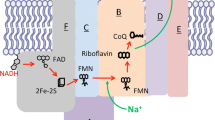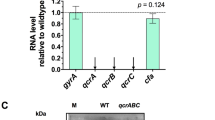Abstract
Tokuda and Unemoto observed that a concentration of the protonophore carbonyl cyanide m-chlorophenylhydrazone (CCCP) which completely collapsed the membrane potential of the marine bacterium Vibrio alginolyticus 138-2 and the moderate halophile Vibrio costicola at pH 7 only partially and transiently collapsed it at pH 8.5. They also found that a concentration of CCCP which inhibited Na+ extrusion from and Na+ dependent amino acid uptake by V. alginolyticus 138-2 at pH 7.0 did not do so at pH 8.5. To explain these observations they proposed the existence of a primary electrogenic Na+ extrusion system which was uncoupler resistant and functioned best at alkaline pH. The organisms examined have been shown to have a Na+-activated NADH:quinone-acceptor oxidoreductase with a pH optimum at 8. Since mutants of V. alginolyticus 138-2 lacking this enzyme were sensitive to CCCP at pH 8.5, it was concluded that the enzyme functions as the proposed electrogenic Na+ pump. Hamaide et al., however, demonstrated Na+/H+ antiport activity at pH 8.5 inV. costicola which was sensitive to the protonophores CCCP and 3,3’,4’,4-tetrachlorosalicylanilide (TCS). MacLeod et al. found that CCCP inhibited Na+-dependent amino acid uptake into a number of marine bacteria and V. costicola at pH 8.5 if the concentration was increased sufficiently while TCS was almost as inhibitory in this capacity at pH 8.5 as at 7. Relatively low concentrations of TCS collapsed the membrane potential of V. alginolyticus 118 at pH 8.5 and prevented Na+ extrusion from the cells. These findings suggested that NADH oxidation at pH 8.5 in this organism and V. costicola leads to the extrusion of protons which in turn cause Na+ to be pumped out of the cells via a Na+/H+ antiporter. Reasons for the differences in the conclusions reached are discussed.
Access this chapter
Tax calculation will be finalised at checkout
Purchases are for personal use only
Preview
Unable to display preview. Download preview PDF.
Similar content being viewed by others
References
J. L. Reichelt and P. Baumann, Arch. Microbiol.97: 329 (1974)
G. R. Drapeau and R. A. MacLeod, Biochem. Biophys. Res. Comm.12: 111 (1963)
R. Droniuk, P. T. S. Wong, G. Wisse and R. A. MacLeod, Appl. Environ. Microbiol.53: 1487 (1987)
Y. Kakinuma and T. Unemoto, J. Bacteriol.163: 1293 (1985)
H. M. Hassan and R. A. MacLeod, J. Bacteriol.121: 160 (1975)
T. Unemoto, M. Hayashi and M. Hayashi, J. Biochem. (Tokyo)82: 1389 (1977)
G. Khanna, L. DeVoe, L. Brown, D. F. Niven and R. A. MacLeod, J. Bacteriol.157: 59 (1984)
G. D. Sprott, J. P. Drozdowski, E. L. Martin and R. A. MacLeod, Can. J. Microbiol.21: 43 (1975)
J. Thompson and R. A. MacLeod J. Biol. Chem. 248: 7106 (1973)
T. Unemoto and M. Hayashi, J. Biochem. (Tokyo)85: 1461 (1979)
H. Tokuda and T. Unemoto, Biochem. Biophys. Res. Comm.102: 265 (1981)
H. Tokuda, Biochem. Biophys. Res. Comm.114: 113 (1983)
H. Tokuda and T. Unemoto, J. Biol. Chem.259: 7785 (1984)
H. Tokuda and T. Unemoto, J. Bacteriol.156: 636 (1983)
T. Tsuchiya and S. Shinoda J. Bacterial. 162: 794 (1985)
S. Ken-Dror, R. Preger and Y. Avi-Dor, Arch. Biochim. Biophys.244: 122 (1986)
P. A. Dibrov, V. S. Kostyrko, R. L. Lazarova, V. P. Skulachev and I. A. Smirnova, Biochim. Biophys. Acta850: 449 (1986)
P. Dimroth and A. Thomer, Arch. Microbiol.151: 439 (1989)
V. Müller, C. Winner and G. Gottschalk, Eur. J. Biochem.178: 519 (1988)
F. Hamaide, D. J. Kushner and G. D. Sprott, J. Bacteriol.161: 681 (1985)
T. A. Krulwich, Biochim. Biophys. Acta726: 245 (1983)
F. Hamaide, G. D. Sprott, and D. J. Kushner, Biochim. Biophys. Acta766: 77 (1984)
R. A. MacLeod, G. A. Wisse and F. L. Stejskal, J. Bacteriol.170: 4330 (1988)
H. Tokuda, Methods Enzymol. 125: 520 (1986)
S. G. A. McLaughlin and J. P. Dilger, Physiol. Rev.60: 825 (1980)
H. Tokuda and T. Unemoto, J. Biol. Chem.257: 10007 (1982)
U. Hopfer, A. L. Lehninger and W. J. Lennarz, J. Membr. Biol.3: 142 (1970)
R. J. Lewis, E. Kaback and T. A. Krulwich, J. Gen. Microbiol.128: 427 (1982)
A. A. Guffanti and T. A. Krulwich, J. Biol. Chem.263: 14748 (1988)
R. J. P. Williams, FEBS Lett. 85: 9 (1978)
F. Hamaide, D. J. Kushner and G. D. Sprott, J. Bacteriol.156: 537 (1983)
Author information
Authors and Affiliations
Editor information
Editors and Affiliations
Rights and permissions
Copyright information
© 1991 Springer Science+Business Media New York
About this chapter
Cite this chapter
MacLeod, R.A. (1991). Is the Na+-Activated NADH-Quinone-Acceptor Oxidoreductase in Marine Bacteria and Moderate Halophiles a Primary Electrogenic Na+ Pump?. In: Rodriguez-Valera, F. (eds) General and Applied Aspects of Halophilic Microorganisms. NATO ASI Series, vol 201. Springer, Boston, MA. https://doi.org/10.1007/978-1-4615-3730-4_12
Download citation
DOI: https://doi.org/10.1007/978-1-4615-3730-4_12
Publisher Name: Springer, Boston, MA
Print ISBN: 978-1-4613-6660-7
Online ISBN: 978-1-4615-3730-4
eBook Packages: Springer Book Archive




